Gevork Aristakesyan
Staff Writer

On Thursday, September 23, the Armenian Studies Program and the Armenian Students Organization hosted Dr. Hans-Jürgen Feulner, who gave a lecture on the development of the Armenian Divine Liturgy. Dr. Feulner is a university professor for Liturgical Studies and Theology of the Sacraments at the Catholic Faculty of the University of Vienna and the Director of the Institute for Liturgical Studies at the University of Vienna.
Dr. Feulner described the development and meaning of the Armenian Liturgy. The Armenian Church has deep traditions, whose meaning, for some, have become difficult to fully comprehend. What Dr. Feulner was able to do, was explain these various traditions and their meanings.
The Armenian Church worship (yergrbakutyun-literaly “kissing the ground”) is not expressed with words only. Gestures and rituals are also used to express the belief in
God and man’s relationship with him.
Dr. Feulner explained worship in the Armenian Church, one aspect of which is Divine Liturgy or badarak. Badarak, which means sacrifice in Armenian, is considered to be the principle liturgical service of the Armenian Church. Dr. Feulner stated that from the earliest known sources in the Armenian language, the Armenians considered the Badarak to be a prominent expression of their Christian faith.
The Badarak, or Surp Badarak (holy sacrifice) is divided into three parts. The first is the Preparation, during which the priest prepares for the service. The second part is the Synaxis, the assembly or coming together of the people to worship. The final part is the Eucharist or the thanksgiving. Dr. Feulner noted that the Eucharistic prayer that is used today in the Armenian Divine Liturgy is attributed to St. Athanasius of
Alexandria. During the E u c h a r i s t Holy Communion is received. The A r m e n i a n C h u r c h teaches that when Holy Communion is received, the communicant is not eating mere bread and wine, but receiving Christ himself. Holy Communion signifies the unity of the members of the church with each other and with God.
The Armenian Church underwent waves of liturgical influences during its formative period. There were the indigenous elements, which were the Armenian traditions and culture that were adopted in the Divine Liturgy. The other influences were Syrian, Byzantine, and Roman-Latin. The greatest influence came from Syria, followed by the Byzantine influence. During the time of the Crusades (11th-14th centuries) some Latin Roman elements were brought into the Liturgy as well. Dr. Feulner stated that by the 15th century the Liturgy had achieved its final form.
Dr. Feulner gave the audience in-depth insight into the Armenian Church and her traditions. Armenians have always taken pride in their faith and have made great sacrifices for that faith, which is why the lecture was so educational.
 Hye Sharzhoom Armenian Action
Hye Sharzhoom Armenian Action